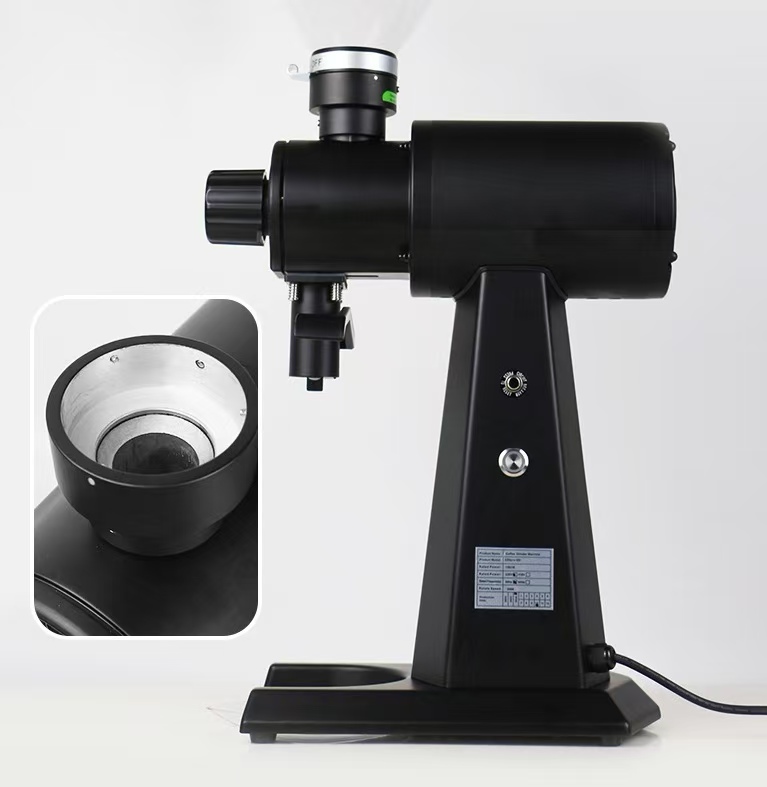The maintenance of coffee grinders should be carried out from multiple aspects such as daily cleaning, regular deep maintenance, component replacement and operation norms. The following are the specific maintenance methods:
First, daily cleaning
External cleaning of the fuselage
After each use, wipe the body with a slightly damp soft cloth to remove coffee powder residue and grease.
If a cleaner is needed, choose a mild and non-corrosive product. Spray it on a damp cloth and then wipe. Avoid direct contact of the cleaner with the body to prevent it from seeping into the circuit system and causing a short circuit.
Cleaning of grinding components
Hand-cranked grinding machine: After each grinding, use a small brush to clean the bottom of the grinding disc, the powder bin and the grinding bean bin. You can also assist in cleaning the residual powder by patting.
Electric grinding machine: Daily cleaning mainly focuses on fine powder. A small brush or dust blower can be used to clean the outlet to prevent coffee powder from accumulating and affecting the grinding effect.
Cleaning of steam pipes and steam systems (if applicable) :
After using the steam rod, immediately wipe the pipe opening with a damp towel and briefly turn on the steam switch to use the force and high temperature of the steam ejection to clean the milk dirt remaining in the jet hole.
If there is milk scale remaining on the steam stick, you can fill a milk tank to eight-tenths full with hot water, soak the steam stick in it to soften the milk scale, and then perform the wiping and empty spraying operations.
Second, regular in-depth maintenance
Disassembly and cleaning:
Hand-cranked grinding machine: Those that are frequently used need to be disassembled and cleaned once every half a month, mainly to remove the coffee residue on the bearings and the cutter head. The disassembled cutter head should be cleaned with a small brush or a clean towel. It is not recommended to rinse it with water. When cleaning, you can observe whether the cutter head is damaged. If it is damaged, it should be replaced in time to avoid affecting the grinding fineness.
Electric grinding machine: Frequently used ones need to be disassembled and cleaned once every half a month to a month. Disassembly is relatively complicated and it is not recommended for beginners to operate. It can be sent to a professional coffee shop or college for cleaning and maintenance. The grinding disc can also be cleaned with professional cleaning products every three days, usually by grinding food safety particles, absorbing oil from the grinding disc and discharging the remaining grinding debris.
Deep descaling
If the local water quality is hard and the scale problem is serious, the coffee grinder needs to be descaled regularly. You can use a dedicated descaling agent or food-grade citric acid solution (mixed in the proportion specified in the instructions), and run the cleaning program. After cleaning, be sure to rinse with clean water in a circulating manner 2-3 times to avoid any residue of the agent.
Third, component replacement
Filter screen and sealing ring:
Regularly check whether the filter screen is clean and if there is any coffee grounds blocking it. If the usage frequency is high, the filter screen can be replaced every 3 to 6 months to ensure the quality and taste of the coffee.
Pay attention to the condition of the sealing ring of the brewing head. If the coffee leaks out along the handle during extraction or the handle needs to be tightened to the right significantly, it indicates that the sealing ring may have carbonized and lost its sealing function. It should be replaced in time to extend the service life of the card holder.
Water filter
The water filter is crucial for ensuring the flavor of coffee extraction and extending the service life of the coffee grinder. For general household use, it is recommended to replace it every six months or so, and for commercial use, every three months. The specific time can be determined based on actual usage and water quality. If the water filter is found to have changed color, impurities, or if the steam flow is not smooth and becomes smaller or no steam is produced, it should be replaced immediately.
Fourth, operation norms and precautions
“Washing and grinding” before grinding:
To prevent coffee from absorbing or spitting out coffee grounds and causing flavors to mix, a small amount of coffee beans can be used for “washing and grinding” before grinding to remove any old coffee grounds remaining in the grinder.
Store coffee beans correctly:
Pour the coffee beans into the coffee bin according to the daily usage. The coffee beans that are not used up on the same day should be taken out and placed after the machine is used up. Do not keep them in the coffee bin for a long time to prevent the coffee beans from getting damp and deteriorating, which may affect the grinding effect.
Clean up the residual powder in time:
The remaining coffee beans in the knife tray can be cleaned up by grinding, and then the residual powder can be thoroughly cleaned with a brush or air blowing. Wipe the bean barn clean with a paper towel to keep it dry.
Avoid incorrect operations:
Do not use sharp objects such as steel wool balls to clean the steam rods and grinding machine components to avoid scratching the surface, which may affect the performance and service life of the equipment.
Use the cleaning agent strictly in accordance with the prescribed dosage to avoid corrosion inside the coffee grinder due to excessive use.


